Table of Contents
- Introduction
- Editor’s Choice
- Fitness Equipment Market Overview
- Revenue of the Exercise Equipment Market Worldwide
- Revenue of the Sports Equipment Industry Worldwide
- Global Functional Fitness Equipment Market Size
- Global Growth of CrossFit Affiliates Statistics
- CrossFit Affiliates – By Country Statistics
- Demographics of CrossFit Users Statistics
- Popular CrossFit Workout Statistics
- Key Performance Benchmarks for Competitive CrossFit Athletes Statistics
- The CrossFit Open: Pathway to the CrossFit Games Statistics
- Nutrition Habits Among CrossFit Participants Statistics
- The Physical and Mental Benefits of CrossFit Statistics
- Key Business Insights for CrossFit Boxes Statistics
- The Impact of Corporate CrossFit Programs on Workplace Wellness Statistics
- The Role of Community in CrossFit’s Popularity Statistics
- The Integration of Technology in CrossFit Statistics
- A Global Stage: Highlights from the CrossFit Games Statistics
- Cash Prizes at the CrossFit Games Statistics
- The Evolution of CrossFit in the U.S. Statistics
- Key CrossFit Trends
- Impact of COVID-19
- CrossFit Injuries Statistics
- CrossFit Regulations
- Recent Developments
- Conclusion
- FAQs
Introduction
CrossFit Statistics: CrossFit is a high-intensity fitness program that combines functional movements, strength training, and cardiovascular exercises to improve overall fitness.
It emphasizes varied workouts (Workouts of the Day or WODs) that target endurance, strength, flexibility, and power and can be scaled to suit all fitness levels.
CrossFit incorporates exercises like Olympic lifts, gymnastics movements, and bodyweight exercises, often structured in formats like AMRAP, EMOM, or Tabata.
Known for its strong community support, CrossFit offers benefits such as improved physical conditioning, weight loss, and mental toughness, though it requires proper technique to minimize injury risk.

Editor’s Choice
- Globally, the number of CrossFit affiliates surpassed 13,000 in 2023.
- The distribution of CrossFit affiliates showcases the sport’s global presence, with the United States leading by a significant margin at 5,000 affiliates.
- According to Rally Fitness, 18% of CrossFit athletes are under the age of 18. Reflecting strong youth engagement in the sport.
- Nutrition plays a significant role in the CrossFit community, with 70% of participants following a structured nutrition plan.
- CrossFit offers significant physical and mental benefits, with participants experiencing an average 20% improvement in overall fitness within the first three months.
- CrossFit-style workouts are becoming a key component of corporate wellness initiatives. With 20% of Fortune 500 companies incorporating them into their programs.
- Community plays a central role in CrossFit’s appeal, with 90% of participants citing it as a key reason for their continued involvement.
- Injuries in CrossFit training are distributed across various body parts. With the shoulder being the most commonly affected site, accounting for 28.28% of reported injuries.
Fitness Equipment Market Overview
Global Fitness Equipment Market Value
- The global fitness equipment market experienced notable fluctuations and growth between 2016 and 2020, with subsequent projections extending to 2028.
- In 2016, the market value was approximately USD 10,503.76 million. Which increased steadily over the next three years, reaching USD 11,725.92 million in 2019.
- However, the market faced a significant decline in 2020, dropping to USD 9,067.46 million, largely attributable to the impact of the COVID-19 pandemic on the fitness industry.
- Recovery commenced in 2021, with the market value rising to USD 10,229.44 million. Followed by further growth in 2022 to USD 11,285.77 million.
- The upward trajectory is expected to continue. The market is projected to reach USD 12,142.76 million in 2023 and USD 12,580.41 million in 2024.
- By 2025, the market is anticipated to grow to USD 13,028.84 million. Followed by USD 13,489.87 million in 2026 and USD 13,961.86 million in 2027.
- The forecast for 2028 predicts a market value of USD 14,445.84 million. Reflecting sustained growth in the global fitness equipment industry.
(Source: Statista)
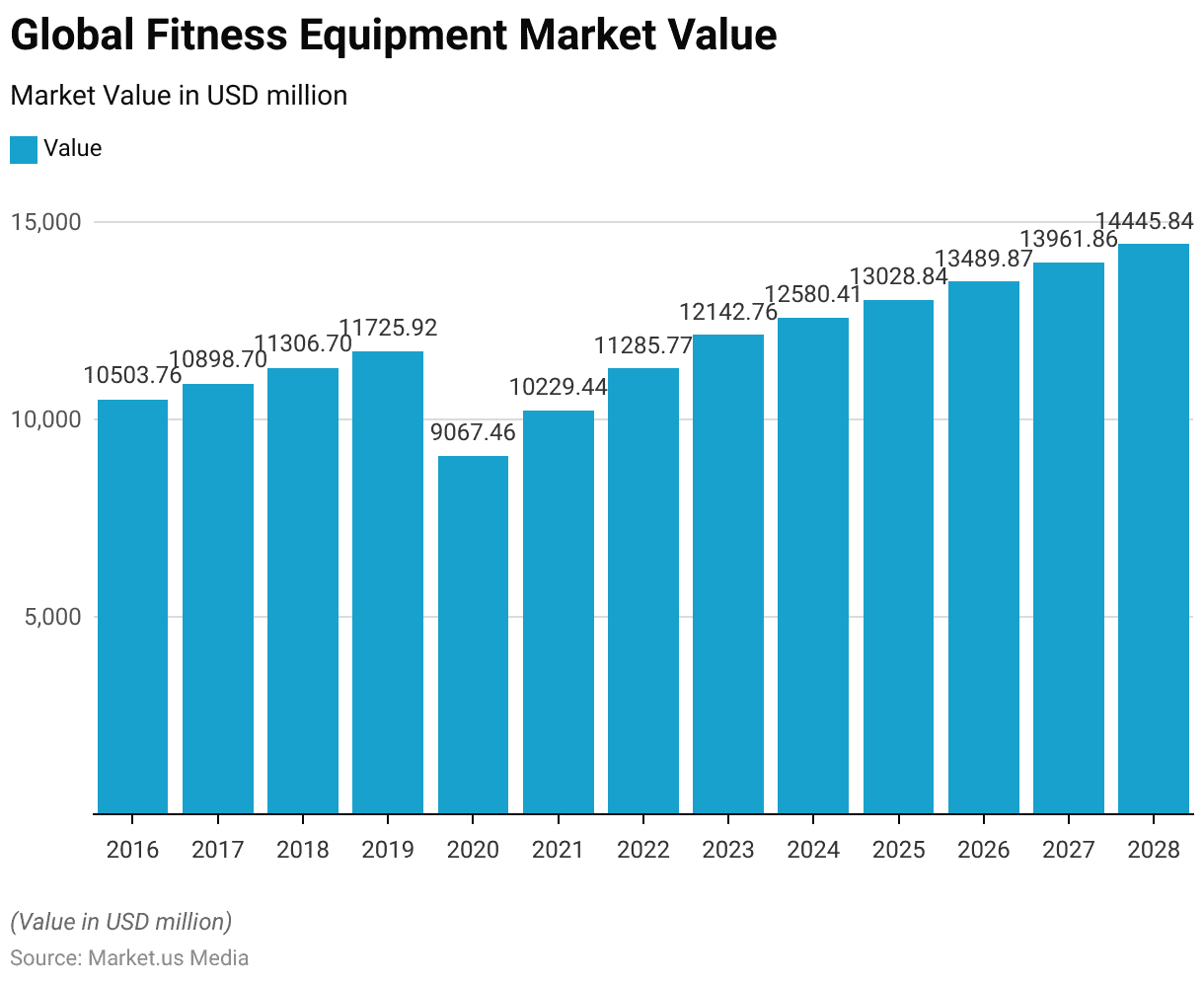
Value of the Global Fitness Equipment Market – By Equipment Type
- The global fitness equipment market is segmented by type. It has shown notable trends and growth patterns from 2016 to 2020, with forecasts extending to 2028.
- In 2016, cardiovascular equipment dominated the market with a value of USD 5,907.94 million. Followed by strength training equipment at USD 4,055.92 million and other equipment at USD 539.82 million.
- By 2019, these values had increased to USD 6,632.65 million, USD 4,511.66 million, and USD 581.61 million, respectively.
- However, the market faced a downturn in 2020, with cardiovascular and strength training equipment declining to USD 5,138.53 million and USD 3,484.62 million, respectively. While other equipment fell to USD 444.31 million, primarily due to the COVID-19 pandemic’s impact.
- Recovery began in 2021, with cardiovascular equipment rising to USD 5,807.87 million. Strength training equipment to USD 3,296.47 million, and other equipment to USD 495.11 million.
- The market is expected to continue growing, with cardiovascular equipment projected to reach USD 6,919.92 million in 2023 and USD 8,308.96 million by 2028.
- Similarly, strength training equipment is forecasted to grow to USD 4,649.71 million in 2023 and USD 5,498.38 million by 2028.
- Other equipment is also anticipated to increase steadily, from USD 573.14 million in 2023 to USD 638.51 million in 2028. Reflecting sustained demand across all segments of the global fitness equipment market.
(Source: Statista)
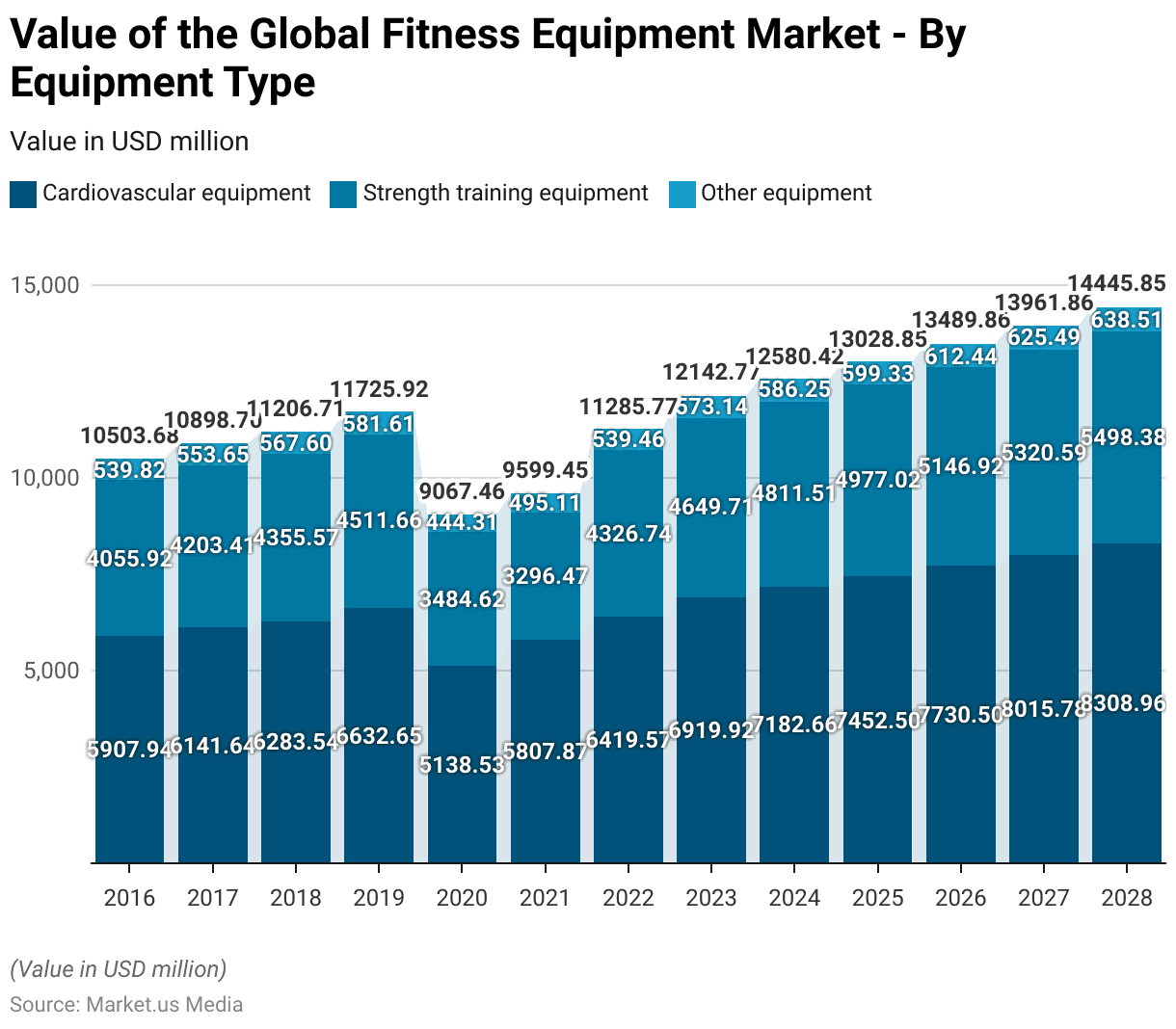
CAGR of the Global Fitness Equipment Market – By Region
- The global fitness equipment market is expected to exhibit a compound annual growth rate (CAGR) of 5.05% from 2021 to 2028, with regional variations influencing this overall growth.
- The Asia-Pacific region is projected to lead the market with the highest CAGR of 7.72%. Driven by increasing health awareness and rising disposable incomes.
- The Rest of the World region follows, with a robust CAGR of 5.84%. Reflecting the growing adoption of fitness equipment in emerging markets.
- Europe is expected to witness a CAGR of 4.88%. Supported by a well-established fitness culture and technological advancements in fitness equipment.
- North America, although experiencing relatively slower growth, is forecasted to achieve a CAGR of 3.23%. Underscoring its maturity as a market and consistent demand for fitness products.
- This data highlights the diverse growth trajectories across regions within the global fitness equipment market.
(Source: Statista)
Take advantage of our unbeatable offer - buy now!

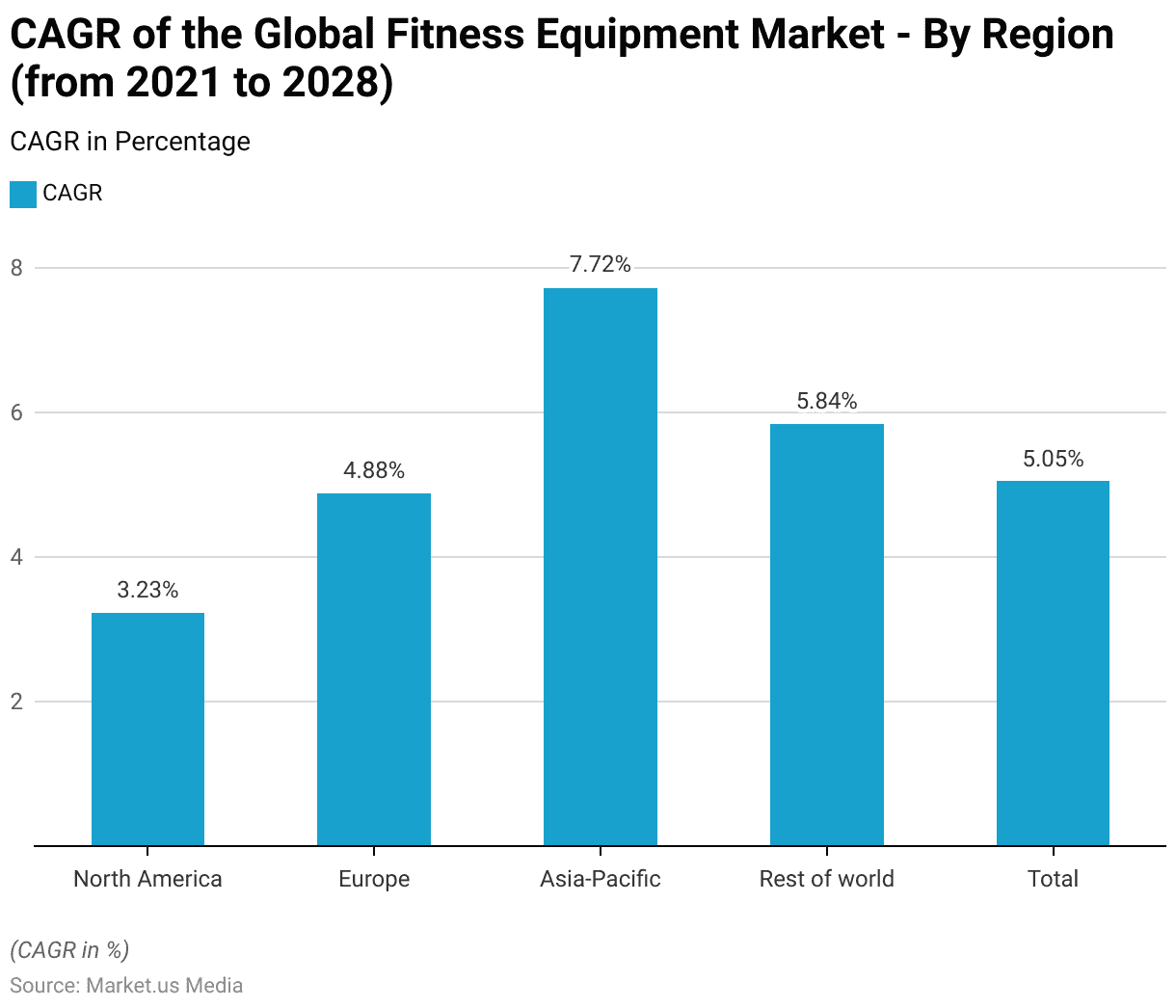
Revenue of the Exercise Equipment Market Worldwide
- The global exercise equipment market has experienced steady growth, with revenue increasing from USD 33.83 billion in 2019 to USD 43.72 billion in 2023.
- Despite the challenges posed by the COVID-19 pandemic. Which saw revenue rise to USD 34.92 billion in 2020, the market continued to expand, reaching USD 40.78 billion in 2022.
- Projections indicate that this upward trend will persist, with revenue expected to grow to USD 46.72 billion in 2024 and further to USD 49.81 billion in 2025.
- By 2026, the market is anticipated to generate USD 53.06 billion. Rising to USD 56.25 billion in 2027, USD 59.47 billion in 2028, and USD 62.69 billion by 2029.
- This sustained growth highlights the increasing global demand for exercise equipment as health and fitness awareness continues to rise.
(Source: Statista)

Revenue of the Sports Equipment Industry Worldwide
- The global sports equipment market has experienced consistent growth over the past decade, with revenue increasing from USD 128.08 billion in 2019 to USD 160.89 billion in 2023.
- Although there was a slight decline to USD 127.65 billion in 2020, likely due to the COVID-19 pandemic, the market quickly rebounded, reaching USD 149.51 billion in 2022.
- Projections indicate that this upward trend will continue, with revenue expected to rise to USD 171.57 billion in 2024, USD 182.29 billion in 2025, and USD 193.48 billion in 2026.
- By 2027, the market is forecasted to reach USD 204.48 billion. Further growing to USD 215.54 billion in 2028 and USD 226.59 billion by 2029. Highlighting the sustained demand and expanding consumer base for sports equipment worldwide.
(Source: Statista)
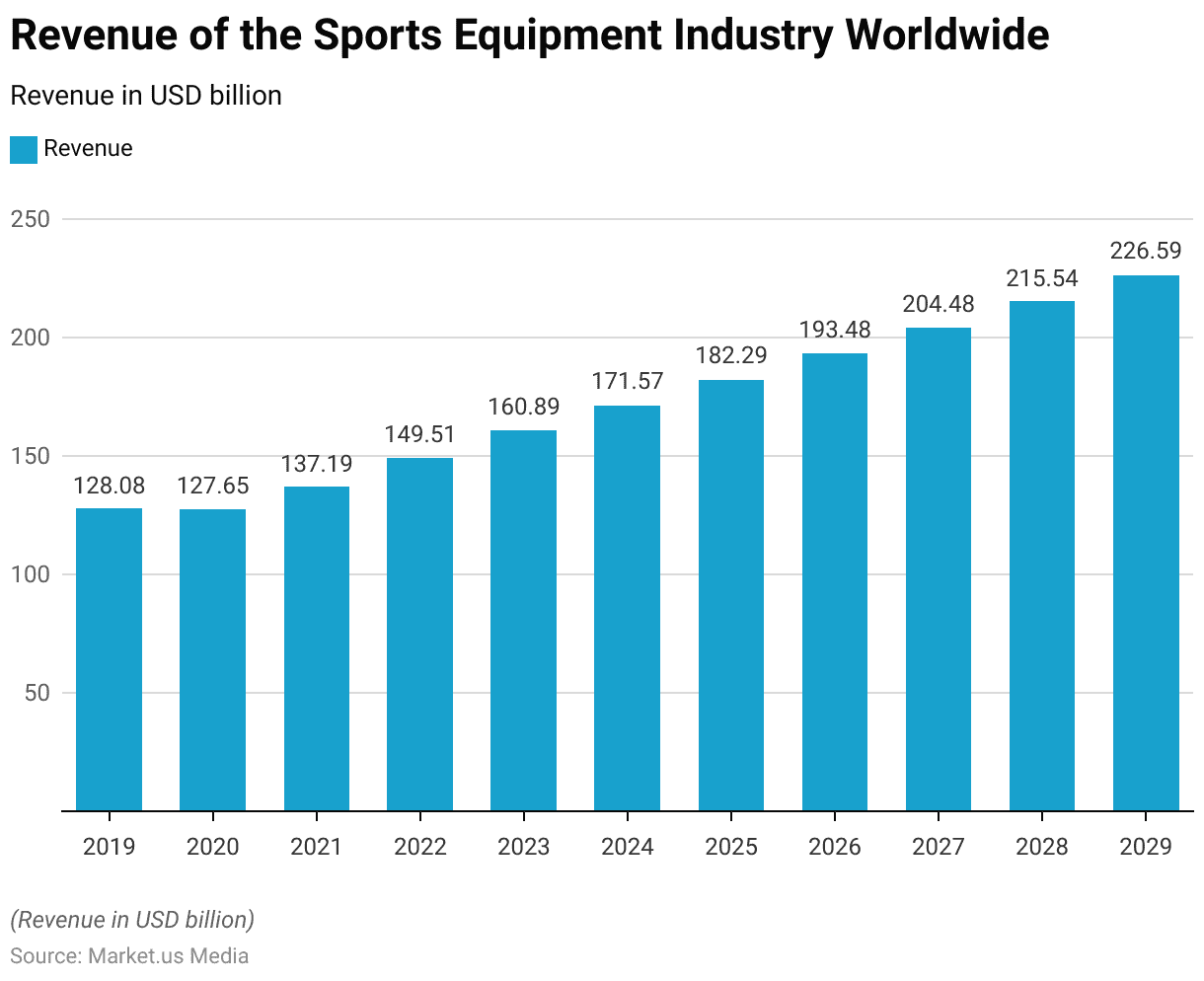
Global Functional Fitness Equipment Market Size
- The global functional fitness equipment market is projected to witness substantial growth over the next decade at a CAGR of 43.2%.
- In 2022, the market size was valued at USD 10.2 billion. Which is expected to rise significantly to USD 14.6 billion in 2023 and USD 20.9 billion in 2024.
- By 2025, the market is projected to reach USD 30 billion. Continuing its upward trajectory to USD 42.9 billion in 2026 and USD 61.4 billion in 2027.
- This rapid expansion is forecasted to accelerate further. The market size is expected to hit USD 88 billion in 2028, USD 126 billion in 2029, and USD 180.4 billion by 2030.
- By 2031, the market is anticipated to grow to USD 258.3 billion. Ultimately reaching USD 369.9 billion by 2032. Reflecting robust demand and widespread adoption of functional fitness equipment worldwide.
(Source: market.us)

Global Growth of CrossFit Affiliates Statistics
- The growth of CrossFit affiliates over the years highlights the brand’s remarkable global expansion.
- Starting with just 13 affiliates in 2005, the network grew rapidly to 500 affiliates by 2008.
- This growth accelerated further, reaching 1,700 affiliates in 2010 and doubling to 3,400 by 2012.
- By 2014, the number of affiliates had surged to 7,000, and by 2016, it had nearly doubled again to 13,000 affiliates.
- The peak was reached in 2018 with 15,000 affiliates.
- However, the COVID-19 pandemic led to a slight decline, reducing the number of affiliates to 14,000 by 2020.
- By 2022, the count decreased further to 12,500 affiliates but showed signs of recovery in 2023, surpassing 13,000 affiliates, demonstrating the resilience and sustained popularity of the CrossFit brand worldwide.
(Source: CrossFit)
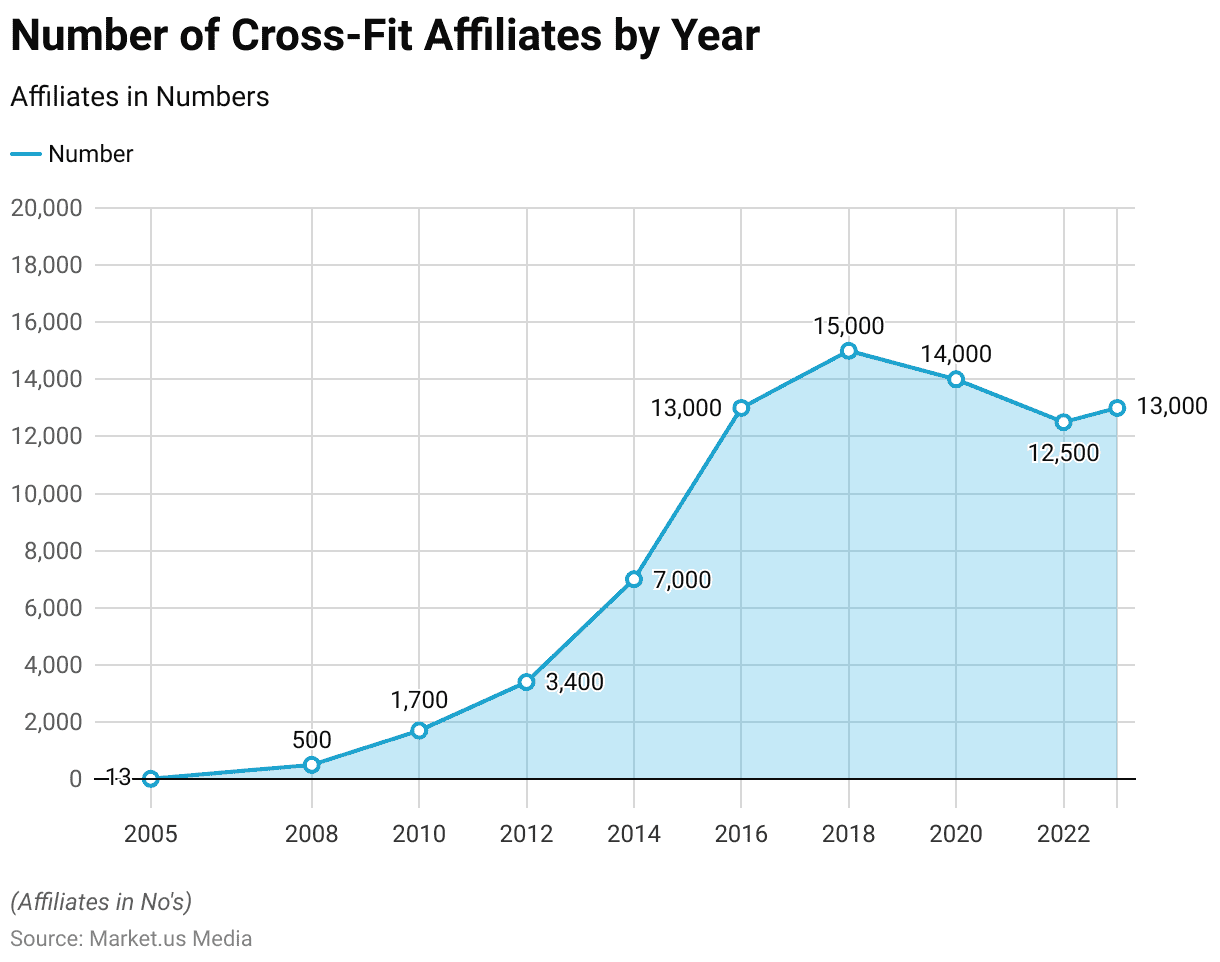
CrossFit Affiliates – By Country Statistics
- The distribution of CrossFit affiliates showcases the sport’s global presence, with the United States leading by a significant margin at 5,000 affiliates.
- Brazil follows as the second-largest market with 1,149 affiliates, reflecting the sport’s popularity in South America.
- Italy ranks third with 662 affiliates, while Australia and Canada each have 588 affiliates.
- The United Kingdom closely follows with 572 affiliates, and France rounds out the list with 481 affiliates.
- This data highlights CrossFit’s widespread adoption across various regions, with notable concentrations in North America, Europe, and South America.
(Source: CrossFit)
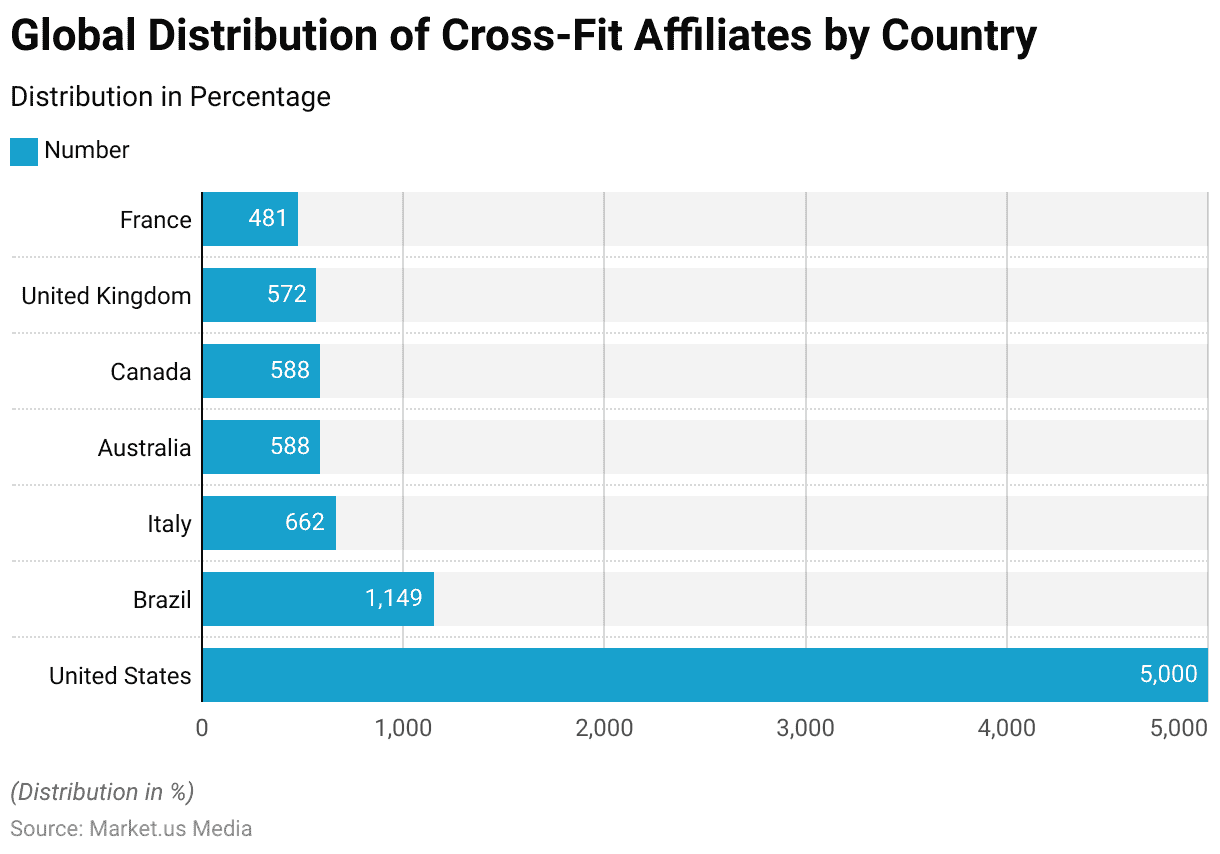
Demographics of CrossFit Users Statistics
By Age
- CrossFit is a sport that appeals to a diverse age range, with participation spanning from younger athletes to seniors.
- According to Rally Fitness, 18% of CrossFit athletes are under the age of 18, reflecting strong youth engagement in the sport.
- The 18 to 24 age group accounts for 6% of participants, while the largest demographic is the 25 to 34 age group, comprising 40% of all athletes.
- The 35 to 44 age group follows, making up 20% of participants.
- In the older age brackets, 8% of athletes fall within the 45 to 54 age range. While 2% are aged 55 to 64.
- Notably, 5% of CrossFit athletes are 65 years or older, underscoring the sport’s accessibility and appeal across all age groups.
(Source: Rally Fitness)
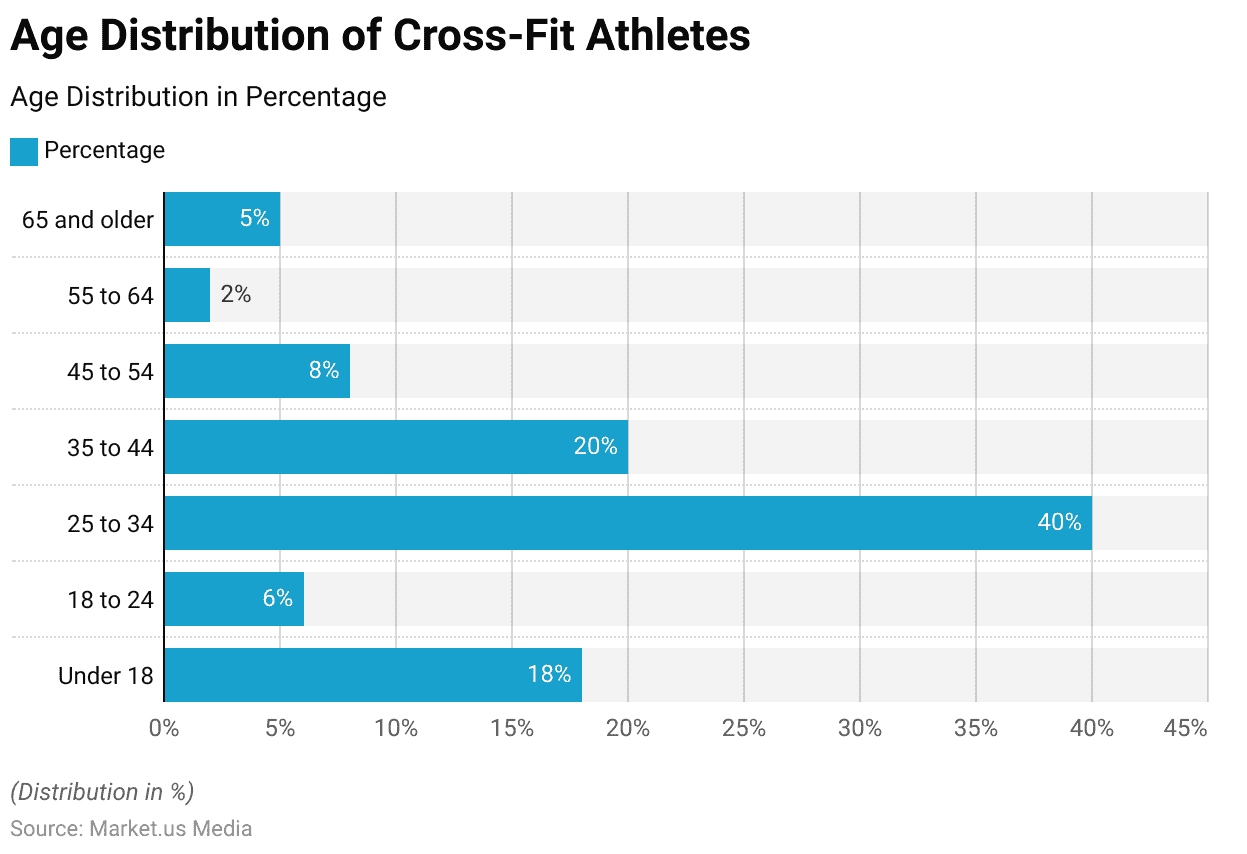
By Gender
- CrossFit Fortify, a gym in Richwood, Texas, notes that CrossFit participation is evenly split between men and women.
- At the annual CrossFit Games, 40 men and 40 women compete for the title of “Fittest on Earth.”
- In the 2021 CrossFit Games, Tia-Clair Toomey tied Mat Fraser’s record of five wins, earning $310,000, the same as men’s champion Justin Medeiros.
- Second-place finishers Laura Horváth and Patrick Vellner received $120,000 each, while Brent Fikowski and Annie Thorisdottir, in third, won $80,000.
- The Games feature top athletes from various divisions, including individual, adaptive, and age-group categories. Women’s events, streamed to 99 million viewers, consistently generate strong audience interest and ticket sales.
(Sources: CrossFit Fortify, CrossFit Games)
Others
- About 40% of CrossFitters hold post-graduate degrees, showing that they are hardworking and goal-oriented individuals.
- They likely bring the same dedication and effort to their CrossFit training.
- Additionally, more than 50% of CrossFitters earn an annual income of $150,000 or more.
- This higher income, often linked to advanced degrees, enables them to afford their CrossFit memberships comfortably.
(Source: Rally Fitness)
Popular CrossFit Workout Statistics
- According to Gym Lion’s analysis of Google search queries, several CrossFit workouts stand out as the most popular among fitness enthusiasts.
- These include classic routines like Fran, which combines thrusters and pull-ups in descending reps of 21, 15, and 9, and Cindy, a workout consisting of 5 pull-ups, 10 push-ups, and 15 squats performed in rounds.
- The demanding Murph includes a 1-mile run, followed by 100 pull-ups, 200 push-ups, 300 squats, and another 1-mile run.
- Grace challenges athletes with 30 clean and jerks, while Helen features a 400-meter run, 21 kettlebell swings, and 12 pull-ups.
- Annie focuses on 50, 40, 30, 20, and 10 reps of double unders paired with sit-ups.
- The workout Angie includes 100 reps each of pull-ups, push-ups, sit-ups, and squats, while Jackie combines a 1,000-meter row, 50 thrusters, and 30 pull-ups.
- Linda is structured around decreasing reps of deadlifts, bench presses, and cleans, starting at ten and descending to 1.
- Finally, Diane alternates deadlifts and handstand push-ups with reps of 21, 15, and 9.
- These workouts reflect the varied and intense nature of CrossFit training, appealing to a wide audience.
(Source: Gym Lion)
Key Performance Benchmarks for Competitive CrossFit Athletes Statistics
- To be considered competitive in CrossFit, athletes must meet specific performance benchmarks. As outlined by BoxRox Competitive Fitness Magazine.
- These standards include achieving at least 25 pull-ups for men and 18 for women and performing three muscle-ups regardless of gender.
- For handstand push-ups, men should complete ten reps. While women are expected to achieve 7.
- In weightlifting, men should snatch 90% of their body weight (BW) and women 80%.
- Deadlift and back squat benchmarks are set at three reps of 1.5 times BW for both genders and 1.25 times BW, respectively.
- For pressing, both men and women should lift 70% of their BW for three reps.
- Additionally, endurance is tested with a 1-mile run, with men expected to finish in 7 minutes and women in 7 minutes and 30 seconds.
- These benchmarks highlight the diverse skill set required for competitive CrossFit.
(Source: BoxRox Competitive Fitness Magazine)
The CrossFit Open: Pathway to the CrossFit Games Statistics
- The CrossFit Open is a global competition where hundreds of thousands of athletes participate over three weeks, with a new event released each week.
- Athletes record their results, and the top 10% from each continent advance to the quarterfinals, an online weekend-long competition.
- In 2023, the top 60 men, 60 women, and the top 40 American teams from the quarterfinals moved on to the semifinals.
- These athletes compete at one of 10 events held across six regions: Africa, Asia, Europe, Oceania, North America, and South America, ensuring representation from each region at the CrossFit Games.
- The top athletes advancing to the Games include ten from North America, ten from Europe, six from Oceania, four from Asia, four from South America, and two from Africa, split equally between men and women.
- Each CrossFit Open event includes standard lifts and weights, which serve as benchmarks for competitors, particularly in the 18-to-35 age group, according to the CrossFit Games.
(Source: CrossFit Games, CrossFit Website)
Nutrition Habits Among CrossFit Participants Statistics
- Nutrition plays a significant role in the CrossFit community, with 70% of participants following a structured nutrition plan.
- Among these, 40% adhere to the Paleo diet, while 30% prefer the Zone diet.
- Intermittent fasting is practiced by 30% of CrossFitters.
- Additionally, 60% of CrossFit gyms, known as boxes, offer nutrition seminars or workshops to support their members.
- Since starting CrossFit, 80% of participants report eating more whole foods, and 70% say they drink more water.
- Tracking macronutrients is a habit for 40% of CrossFitters, and half of the participants use protein supplements.
- Notably, 90% of CrossFit athletes feel more aware of their nutrition as a result of their involvement in the sport, highlighting the strong connection between fitness and dietary habits.
(Source: CrossFit Journal)
The Physical and Mental Benefits of CrossFit Statistics
- CrossFit offers significant physical and mental benefits, with participants experiencing an average 20% improvement in overall fitness within the first three months.
- Studies show that CrossFit increases VO2 max by 13.6% and muscle mass by 4.2% within 12 weeks, while body fat percentage decreases by an average of 3.7% in just 10 weeks.
- Additionally, bone density improves by 2.5% over 16 weeks.
- Beyond physical gains, 73% of participants report better sleep quality, and 80% experience higher energy levels in daily life.
- CrossFit also positively impacts mental health, with 65% of participants noting reduced stress and improved mental well-being and 90% reporting enhanced self-confidence.
- Furthermore, 75% of participants claim that CrossFit has boosted their productivity at work, highlighting its broad impact on both personal and professional life.
(Source: CrossFit Journal)
Key Business Insights for CrossFit Boxes Statistics
- The average CrossFit box serves around 150 members, with each paying a monthly membership fee of $150.
- Most boxes generate approximately $250,000 in annual revenue, with a typical profit margin of 20–30% for well-managed operations.
- Beyond group classes, 80% of CrossFit boxes offer personal training services, and 60% provide nutrition coaching.
- To support their operations, 70% use management software such as Exercise.com, while most employ 3-5 full-time coaches.
- Opening a CrossFit box requires an initial investment of $30,000 to $50,000.
- Additionally, 90% of CrossFit boxes offer introductory programs or on-ramp courses to help new members acclimate to the workouts and community.
- These factors illustrate the business structure and growth potential of CrossFit boxes.
(Source: CrossFit Journal, CrossFit Games)
The Impact of Corporate CrossFit Programs on Workplace Wellness Statistics
- CrossFit-style workouts are becoming a key component of corporate wellness initiatives, with 20% of Fortune 500 companies incorporating them into their programs.
- Organizations that offer these workouts report a 25% reduction in healthcare costs and a 60% decrease in employee absenteeism.
- Additionally, 70% of employees participating in corporate CrossFit programs experience improved job satisfaction, while 90% report reduced stress levels.
- These programs have also been linked to a 15% increase in productivity and a 20% boost in employee retention rates.
- HR professionals recognize the mental health benefits, with 80% believing CrossFit contributes to improved employee well-being.
- As a result, the corporate wellness market. Including CrossFit-style programs, is projected to reach $90.7 billion by 2026.
- Notably, 75% of employees express interest in having their companies offer CrossFit or similar high-intensity interval training programs, underscoring the growing demand for fitness initiatives in the workplace.
(Source: CrossFit Journal)
The Role of Community in CrossFit’s Popularity Statistics
- Community plays a central role in CrossFit’s appeal, with 90% of participants citing it as a key reason for their continued involvement.
- The average CrossFit box hosts 4-6 community events annually, fostering strong social connections.
- As a result, 70% of participants reported forming close friendships through CrossFit, and 85% felt more connected to their local community.
- This sense of belonging helps 80% of participants stay committed to their fitness routines.
- Additionally, 50% of CrossFit gyms offer a dedicated social area, and 40% of participants have traveled to other cities or countries to visit CrossFit boxes.
- Many CrossFit gyms also engage with their broader communities, with 60% participating in local charity events and 30% partnering with local businesses.
- The community spirit is contagious, as 75% of CrossFitters recommend the sport to friends and family, further expanding its reach.
(Source: CrossFit Journal)
The Integration of Technology in CrossFit Statistics
- Technology plays a significant role in CrossFit’s growth and engagement.
- Approximately 90% of CrossFit boxes leverage social media for marketing, while 75% have mobile-friendly websites, and 30% offer a dedicated mobile app for members.
- Fitness tracking is popular among participants, with 70% using fitness apps and 60% relying on wearable technology during workouts.
- In the gym, 40% of CrossFit boxes utilize digital leaderboards, and 80% streamline operations with automated billing systems.
- Virtual fitness options are also prevalent, with 50% of CrossFit boxes offering online programming or virtual classes.
- The 2022 CrossFit Games Open saw a 35% rise in online registrations, reflecting the community’s growing digital presence.
- Furthermore, 85% of CrossFitters use YouTube to learn new techniques, highlighting the integration of technology in skill development and workout optimization.
(Source: CrossFit Journal)
A Global Stage: Highlights from the CrossFit Games Statistics
- The CrossFit Games, which began in 2007 in Aromas, California, attract elite athletes from over 120 countries, showcasing the sport’s global reach.
- Despite widespread participation, only a select few compete each year.
- In 2019, the United States sent 34 athletes, the highest of any country, but they accounted for just 11% of all competitors, according to Morning Chalk Up.
- The 2023 CrossFit Games highlighted intense competition, with Laura Horvath winning the women’s division with 966 points, followed by Emma Lawson with 919 points and Arielle Loewen with 883 points.
- In the men’s division, Jeffrey Adler claimed victory with 953 points, while Patrick Vellner and Roman Khrennikov secured second and third place with 837 and 801 points, respectively.
- These performances underscore the high level of talent and determination required to succeed at the Games.
(Sources: BoxRox, Morning Chalk Up Analysis, CrossFit Games)
Cash Prizes at the CrossFit Games Statistics
- The CrossFit Games not only crown the fittest athletes but also award significant cash prizes.
- Top performers in individual events receive $3,000 for first place, $2,000 for second, and $1,000 for third.
- In the 2023 Games, Laura Horvath topped the women’s division, earning $332,000, while Emma Lawson and Arielle Loewen secured $131,000 and $90,000, respectively.
- On the men’s side, Jeffrey Adler won $325,000, with Patrick Vellner earning $130,000 and Roman Khrennikov taking home $92,000.
- These substantial prizes reflect the high stakes and intense competition of the Games.
(Sources: BoxRox, CrossFit Games)
The Evolution of CrossFit in the U.S. Statistics
- CrossFit remains one of the most popular fitness programs in the U.S., with over 5,000 affiliated gyms and thousands of athletes training daily.
- However, in 2020, the brand faced significant backlash when more than 500 gyms disaffiliated following founder Greg Glassman’s controversial comments during the Black Lives Matter movement.
- After Glassman’s resignation in June 2020, Eric Roza became the new CEO, acquiring 100% ownership of CrossFit and placing 1% of the stock in a trust for Glassman’s family.
- In July 2021, Jason Dunlop, formerly of Nike and Starbucks, was appointed president to drive global expansion.
- By August 2022, Don Foul, a former U.S. Marine and CEO with extensive CrossFit experience, succeeded as CEO.
- Affiliating with CrossFit costs about $3,000 annually, and monthly gym memberships range from $135 to $168.
- The sport is most popular in Colorado, Hawaii, Texas, Utah, and Washington, while North and South Dakota see the least participation.
- CrossFit coaches are highly qualified, with 86.6% holding official certification and 26.7% possessing a bachelor’s degree in an exercise-related field, according to a 2016 Orthopedic Reviews study.
- The average annual income of CrossFit participants is around $150,000, and 40% hold post-graduate degrees, highlighting the sport’s appeal to a well-educated and financially secure demographic.
(Sources: Google, CrossFit, Business Insider, Morning Chalk Up, Orthopedic Reviews)
Key CrossFit Trends
- CrossFit has established itself as a global fitness phenomenon, with Brazil hosting the second-largest number of affiliates outside the U.S. and Canada ranking third globally with over 600 affiliates.
- Australia boasts the highest number of CrossFit affiliates per capita, while the UK has more than 500 affiliates, growing at an annual rate of 15%.
- In Europe, CrossFit participation has increased by 40% over the past five years, and in Latin America, it has grown by 25% annually since 2015.
- Asia is experiencing a rapid 20% annual growth in CrossFit, and the Middle East identifies it as the fastest-growing fitness trend.
- In South Africa, participation has surged with a 30% year-over-year increase.
- Additionally, CrossFit has expanded into educational settings. Being introduced in over 100 schools across 20 countries as part of their physical education programs. Further solidifying its global presence.
(Source: CrossFit Journal)
Impact of COVID-19
People Buying Fitness Products in the Pandemic
- During the COVID-19 pandemic in 2021, U.S. consumers demonstrated a strong interest in purchasing home fitness products.
- Weights and dumbbells, along with treadmills, were the most popular items, each purchased by 17% of respondents.
- Yoga mats followed, with 13% of consumers buying them, while 11% invested in weight benches and general workout or exercise machines.
- Fitness bands, expanders, ropes, straps, and pull-up or wall bars were each purchased by 9% of respondents.
- Rowing bars and home cycling machines were chosen by 8%, while 7% opted for hula hoops.
- Steppers and fascia rolls were less popular, purchased by 6% and 5% of respondents, respectively.
- Other items, including connected fitness equipment such as rowing machines, treadmills, and cycling machines, accounted for 2% or less.
- Notably, no respondents reported refraining from buying any fitness products, underscoring the widespread adoption of home fitness solutions during the pandemic.
(Source: Statista)

Consumer Interest in Home Fitness Equipment Purchase Due to COVID-19
- The COVID-19 pandemic in March 2020 led to a significant surge in interest in home fitness equipment in Poland.
- Dumbbells saw the highest year-over-year growth, with an astounding 639% increase in interest.
- Training benches followed with a 207% rise, while interest in bicycles and trainers doubled, showing 100% growth.
- Mats experienced a 97% increase, and rowing machines grew by 84%.
- Treadmills also saw a notable rise in demand, with an 80% increase. Steppers and bars each experienced a 50% growth in interest.
- This data highlights the strong shift toward home-based fitness solutions during the pandemic.
(Source: Statista)
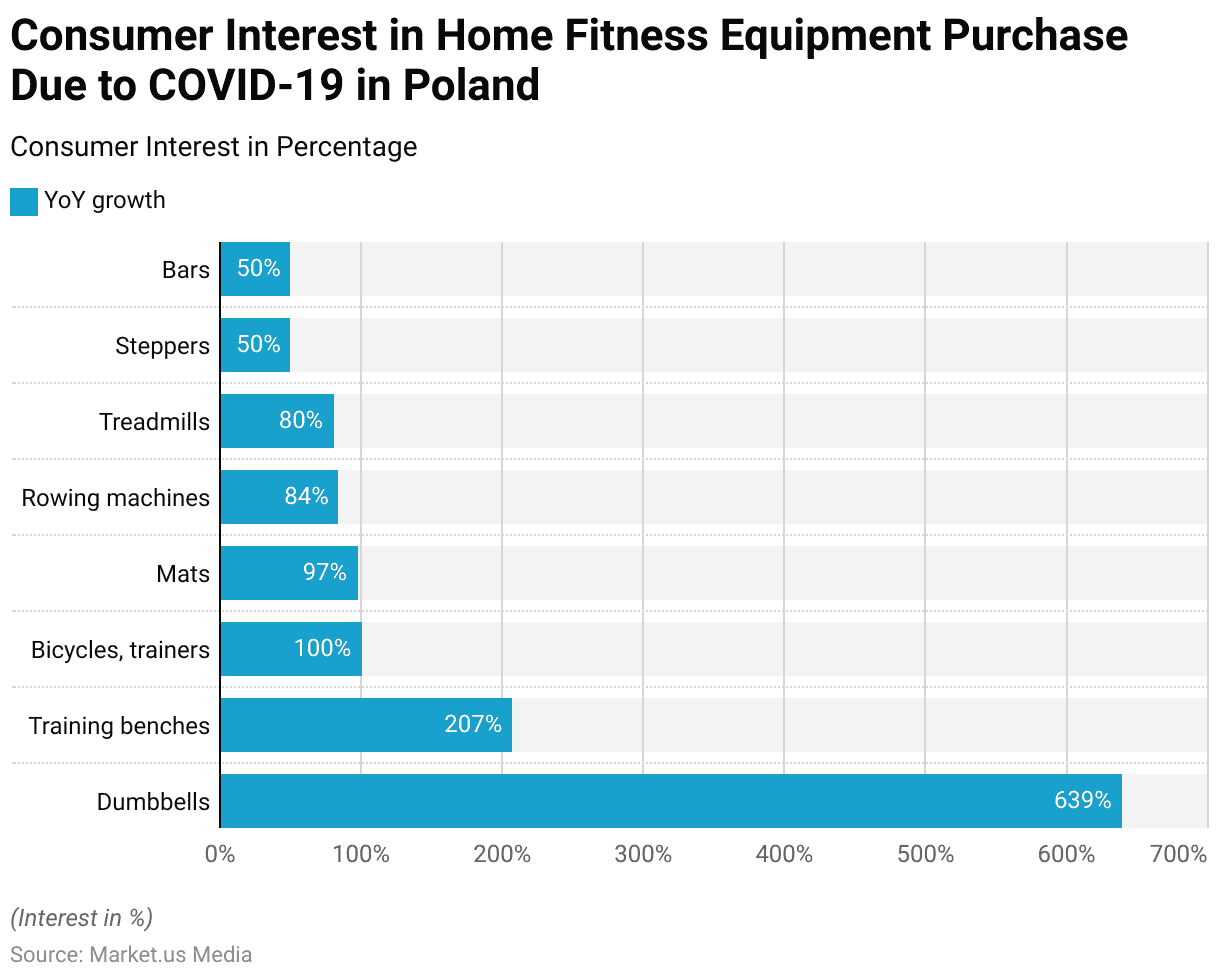
Home Workout Equipment Sales Growth During COVID-19
- During the week of March 9 to March 15, 2020, the demand for home workout equipment in Russia saw notable growth, driven by the COVID-19 pandemic.
- In Moscow, sales increased by 33%, with an average bill growth of 6.5%.
- Across Russia, sales rose by 32%, accompanied by a higher average bill growth of 15%.
- This data reflects the surge in interest in fitness products as consumers adapted to home-based workout routines during the early stages of the pandemic.
(Source: Statista)
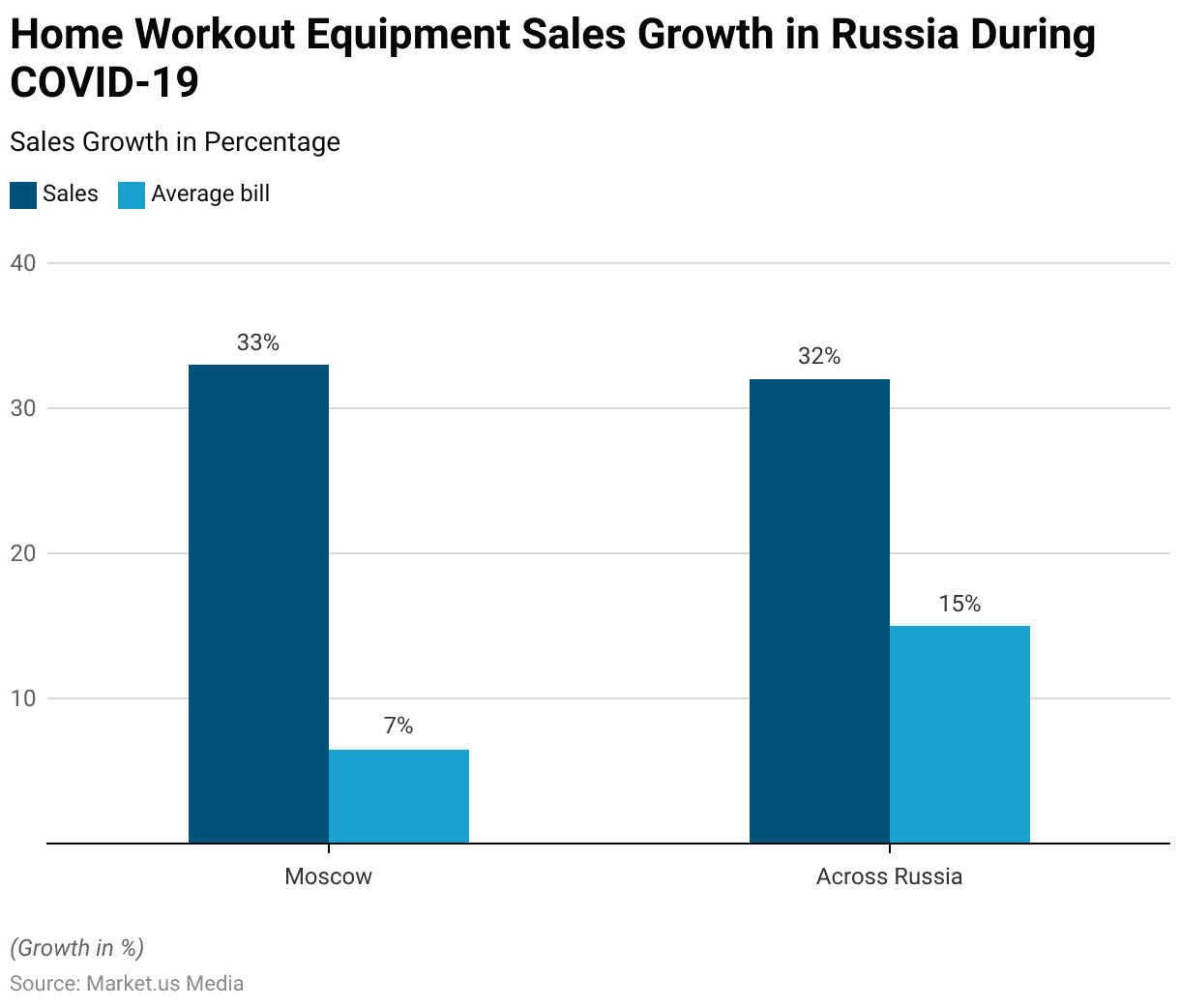
Measures to Reassure Gym Members During COVID-19
- In August 2020, gym members in India identified several measures that could reassure them during the COVID-19 pandemic.
- The most favored precaution across all age groups was making mask-wearing compulsory in gyms, with support ranging from 56% to 60%.
- Ensuring a minimum distance of 1.5 meters between equipment was also popular, particularly among older age groups, with 49% of respondents aged 55 and above supporting this measure.
- Limiting the number of people training at a given time was backed by 39% to 52% of respondents, with the highest support from the 45-54 age group.
- Additional cleaning staff to disinfect equipment after each use was considered important by 22% to 31% of respondents, while temperature checks were supported by 21% to 27%.
- Providing hand sanitizers was favored by 16% to 24%, and implementing a sign-in/out system for contact tracing was suggested by 10% to 15%.
- A minority of respondents (1% to 3%) proposed other measures, while 3% to 8% believed no actions would be effective without a vaccine.
- This data highlights varying levels of concern and preferred safety measures among different age groups during the pandemic.
(Source: Statista)
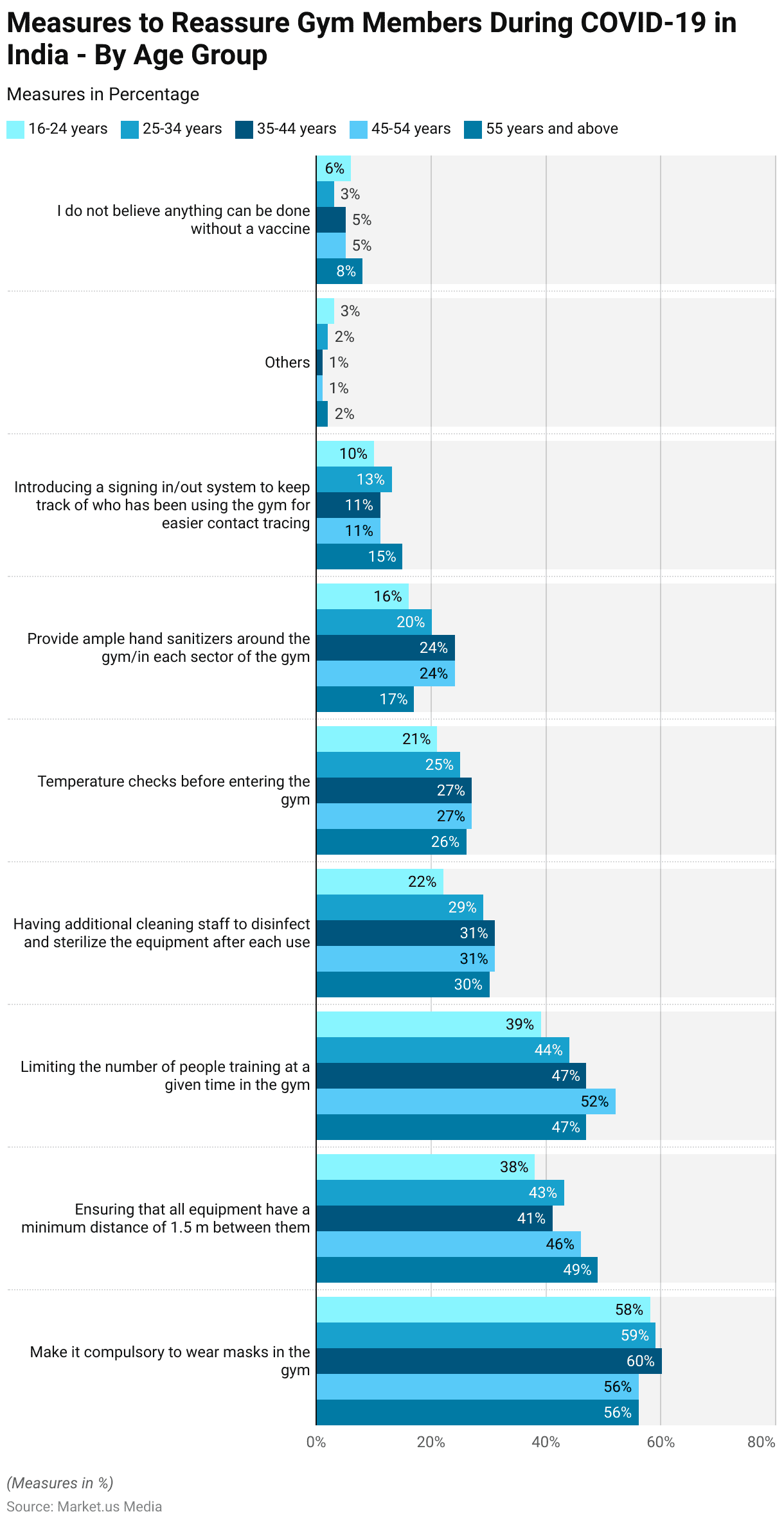
COVID-19 Impact on Usage of Health and Fitness Apps
- As of March 2020, the COVID-19 pandemic significantly boosted the usage of health and fitness mobile apps in India.
- According to a survey, 76% of respondents reported using the HealthifyMe app, making it the most popular among fitness apps.
- The Home Workout – No Equipment app was used by 74% of respondents, reflecting a strong preference for fitness solutions that required minimal resources.
- Similarly, the Six Pack in 28 Days – Abs Workout at Home app was utilized by 71% of respondents, highlighting a growing interest in targeted home-based fitness routines during the pandemic.
- These trends underscore the increased reliance on digital fitness tools amid lockdowns and social distancing measures.
(Source: Statista)
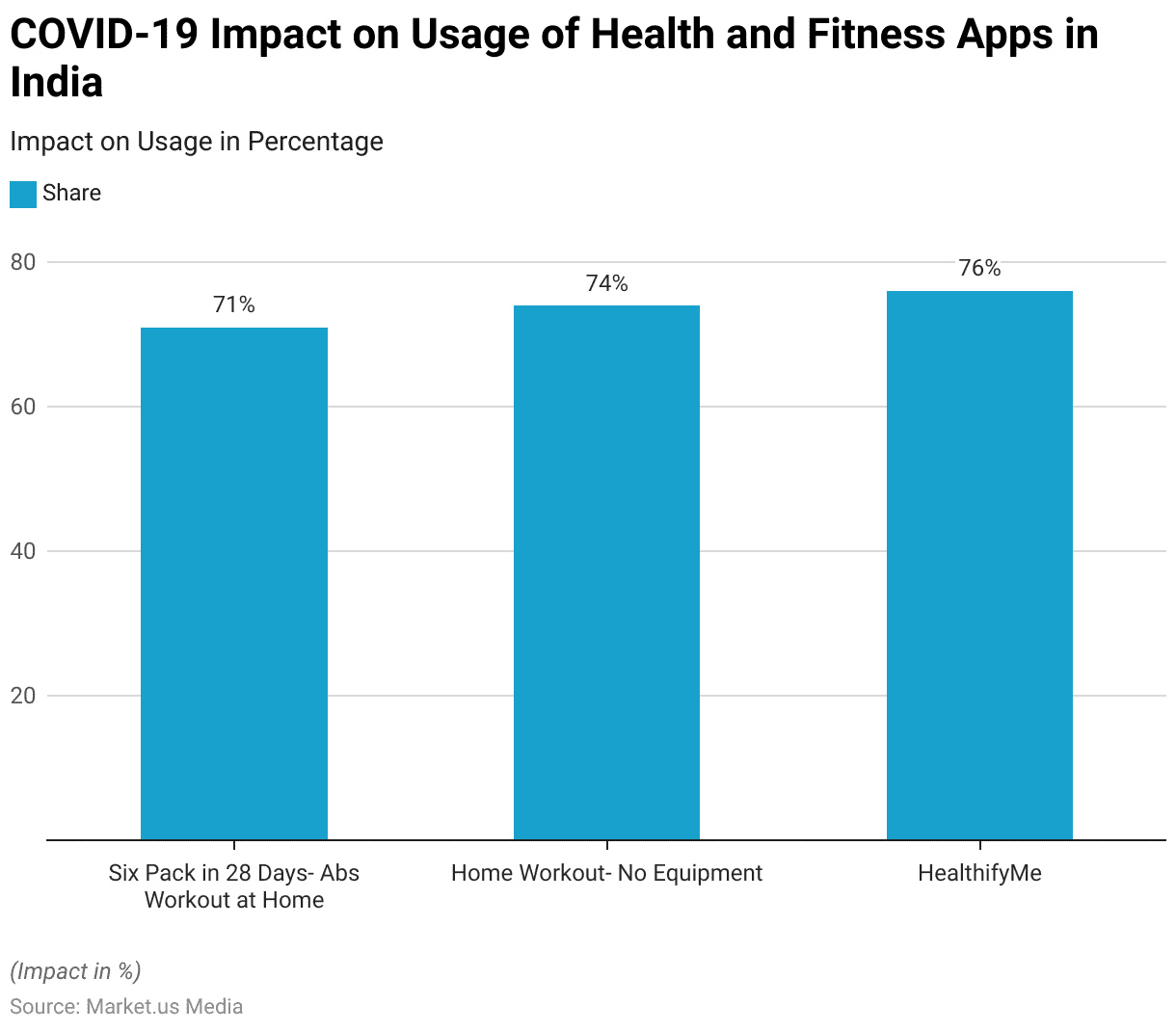
CrossFit Injuries Statistics
CrossFit Injury Site and Occurrence
- Injuries in CrossFit training are distributed across various body parts, with the shoulder being the most commonly affected site, accounting for 28.28% of reported injuries.
- The back follows with 19.27% of injuries, while the knee is affected in 12.95% of cases.
- Wrist and hand injuries make up 8.53%, slightly more frequent than injuries to the elbow (7.27%) and ankle or foot (7.11%).
- Hip injuries are reported by 4.92% of respondents, and neck injuries are less common at 4.11%.
- Additionally, 7.58% of injuries fall into the “other” category, highlighting a range of less common injury sites.
- This data underscores the importance of proper technique and preventive measures in CrossFit to reduce the risk of injury.
(Source: Symbiosis)
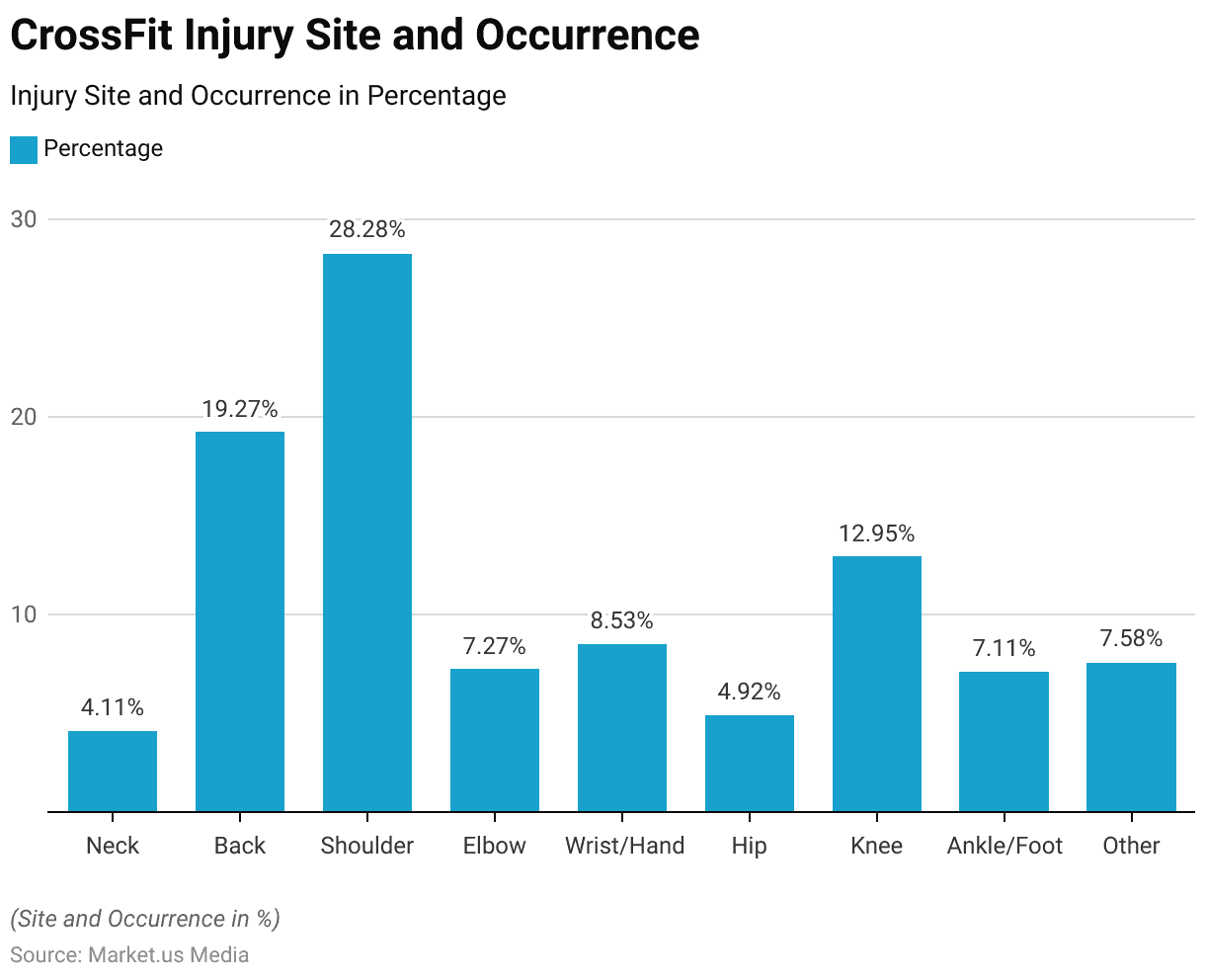
Self-Reporting of CrossFit Injuries
- A self-reported survey on CrossFit injury rates highlights a decline in injury frequency as weekly training hours increase.
- Participants training three or fewer hours per week reported an injury rate of 3.6 per 1,000 training hours.
- Those training 4-6 hours per week experienced a lower injury rate, ranging from 2.66 to 1.77 injuries per 1,000 hours.
- The lowest injury rates were observed among individuals training 7-10 hours per week, with rates between 1.47 and 0.98 injuries per 1,000 hours.
- This data suggests that more frequent training may be associated with improved technique and conditioning, potentially reducing the likelihood of injuries.
(Source: Symbiosis)
Practitioner of Choice to Address CrossFit Injury
- When addressing CrossFit-related injuries, most individuals prefer consulting a physical therapist, with 39.9% of respondents selecting this option.
- Chiropractors are the second most popular choice, favored by 17.1% of respondents, followed by massage therapists at 14.9%.
- Orthopedists are consulted by 12.7% of respondents, while 7.6% turn to primary care providers.
- Athletic trainers are the least preferred, with only 3.9% choosing their services.
- An additional 4% of respondents indicated seeking help from other types of practitioners.
- This data highlights the diverse approaches individuals take when managing CrossFit injuries, with a strong preference for specialized care.
(Source: Symbiosis)
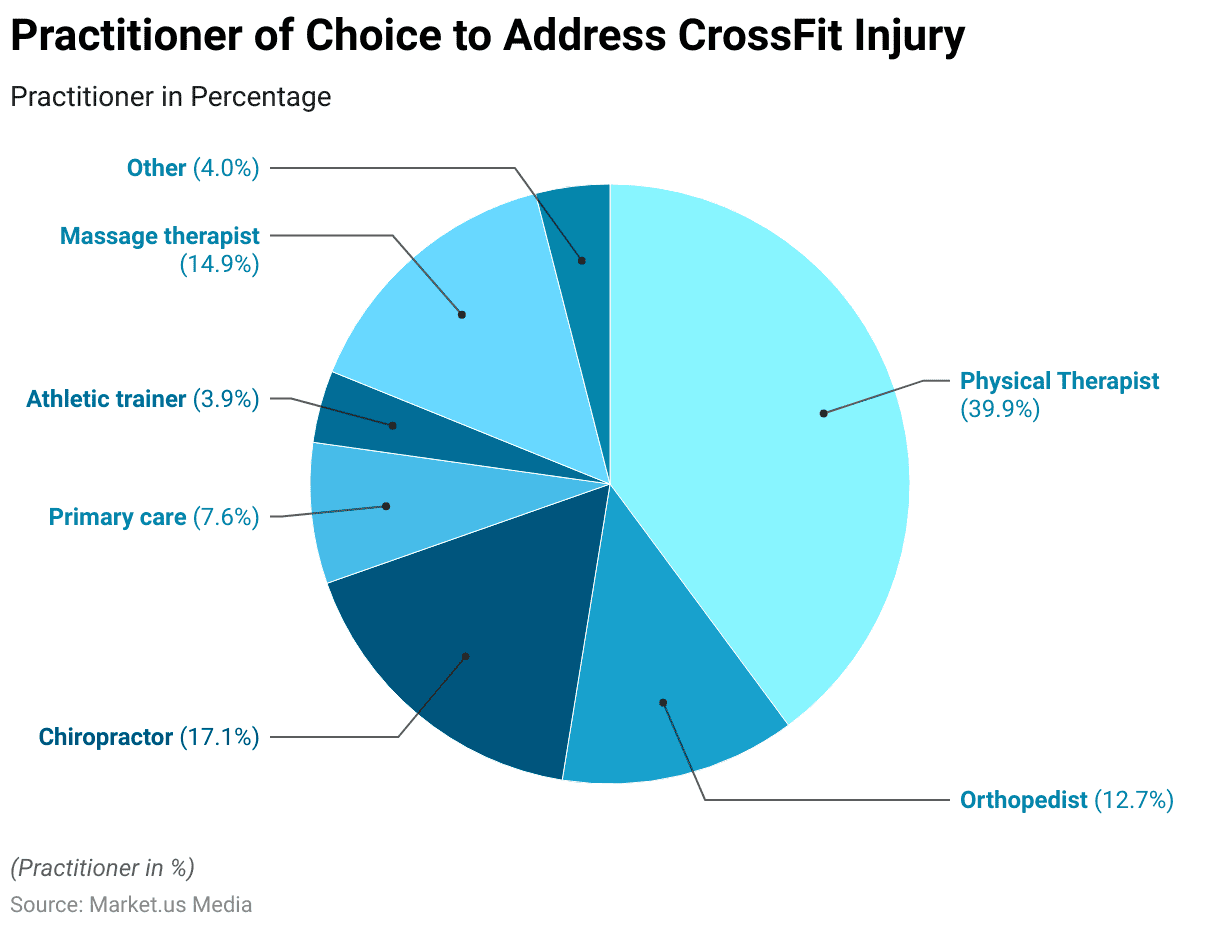
CrossFit Regulations
- CrossFit regulations are influenced by various national and international laws and guidelines, ensuring fairness and safety across different regions.
- CrossFit affiliates must adhere to the rules set by the CrossFit Games Rulebook. Which details the standards for competition across various divisions, including adaptive categories. These divisions allow athletes with disabilities to compete in categories best suited to their abilities. Following strict documentation of their impairments.
- The cost of participating in CrossFit competitions, such as the Open. Varies by country but typically includes a registration fee that all participants must pay.
- Additionally, CrossFit has implemented a drug-testing policy that aligns with the World Anti-Doping Agency’s Prohibited List. Although it primarily applies to athletes rather than other competition personnel.
- This policy dictates both in-competition and out-of-competition testing, with strict penalties for violations, including potential disqualification and loss of prize money.
- Globally, these policies are harmonized with broader anti-doping standards, such as those outlined in the World Anti-Doping Code. This promotes consistency across sports by setting forth international standards for testing, investigations, and exemptions.
- This integrated approach ensures that CrossFit maintains high standards of integrity and competition fairness. Reflecting both local regulations and international best practices.
(Source: Better Health CrossFit, Global Sports Advocates, LLC, World Anti-Doping Agency)
Recent Developments
Acquisitions and Leadership Changes:
- Acquisition by Eric Roza and Berkshire Partners: In July 2020, Eric Roza, alongside Berkshire Partners, acquired CrossFit Inc. for an estimated $200 million. The acquisition aimed to revitalize the brand and expand its global presence. Which had reached over 14,000 affiliate gyms by the time of the deal.
- Appointment of Jason Dunlop as President: In July 2021, CrossFit LLC appointed Jason Dunlop as President. Leveraging his experience from Nike to oversee CrossFit’s operations across 158 countries. Under his leadership, the company aimed to boost its international affiliate growth rate, which increased by 12% year-over-year.
Product and Service Launches:
- CrossFit Affiliate Programming (CAP): In June 2021, CrossFit launched its Affiliate Programming (CAP). Which provides daily training resources to over 5,000 affiliate gyms within the first six months. CAP aims to improve training consistency and has contributed to a 15% increase in member retention rates.
Partnerships and Sponsorships:
- NOBULL as Title Sponsor of the CrossFit Games: In 2021, NOBULL signed a multi-year sponsorship deal worth over $10 million annually. Replacing Reebok as the title sponsor of the CrossFit Games. This partnership significantly boosted brand visibility, with the 2021 Games attracting over 600,000 global participants.
Conclusion
CrossFit Statistics – CrossFit has emerged as a transformative force in the fitness industry. Blending high-intensity functional training with a strong sense of community. Its global appeal is evident, with affiliates in over 120 countries and millions of participants worldwide.
The sport not only enhances physical fitness but also fosters mental resilience, improved health habits, and a supportive social network.
CrossFit’s adaptability, offering everything from home workouts to competitive events like the CrossFit Games, ensures it remains accessible to a diverse audience.
As the fitness landscape continues to evolve, CrossFit’s commitment to innovation, community engagement, and holistic wellness positions it as a leading fitness movement for years to come.
FAQs
CrossFit is a high-intensity fitness program that combines elements of weightlifting, cardio, gymnastics, and functional movements to improve overall fitness. It focuses on varied workouts that challenge different aspects of physical fitness, including strength, endurance, flexibility, and agility.
CrossFit is designed for people of all fitness levels, from beginners to elite athletes. Workouts can be scaled and modified to match an individual’s fitness level, ensuring accessibility for everyone, regardless of age or physical ability.
CrossFit offers numerous benefits, including improved cardiovascular health, increased strength, enhanced endurance, better flexibility, and weight management. It also helps build mental resilience and fosters a sense of community among participants.
CrossFit workouts typically use a variety of equipment, including barbells, kettlebells, dumbbells, pull-up bars, rowing machines, jump ropes, and medicine balls. However, many workouts can be done with minimal or no equipment.
The cost of a CrossFit membership varies depending on the gym (box) and location. In the U.S., the average monthly membership ranges from $135 to $168. Some boxes also offer personal training and online programming for additional fees.
Discuss your needs with our analyst
Please share your requirements with more details so our analyst can check if they can solve your problem(s)



